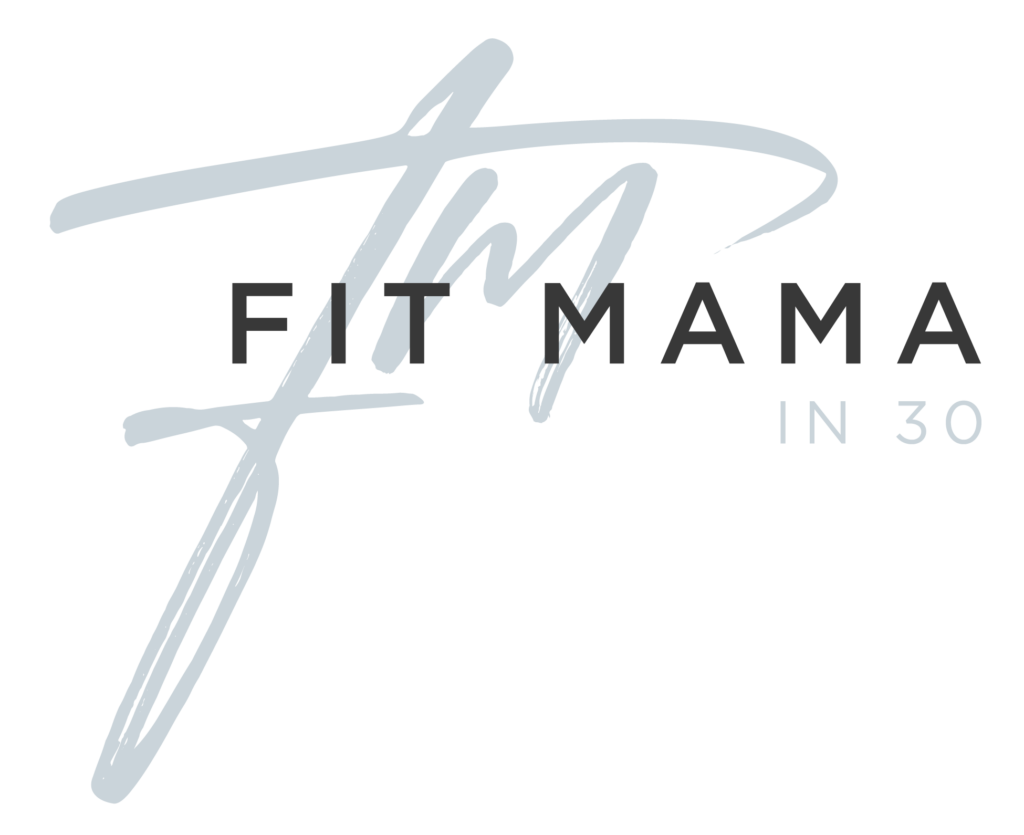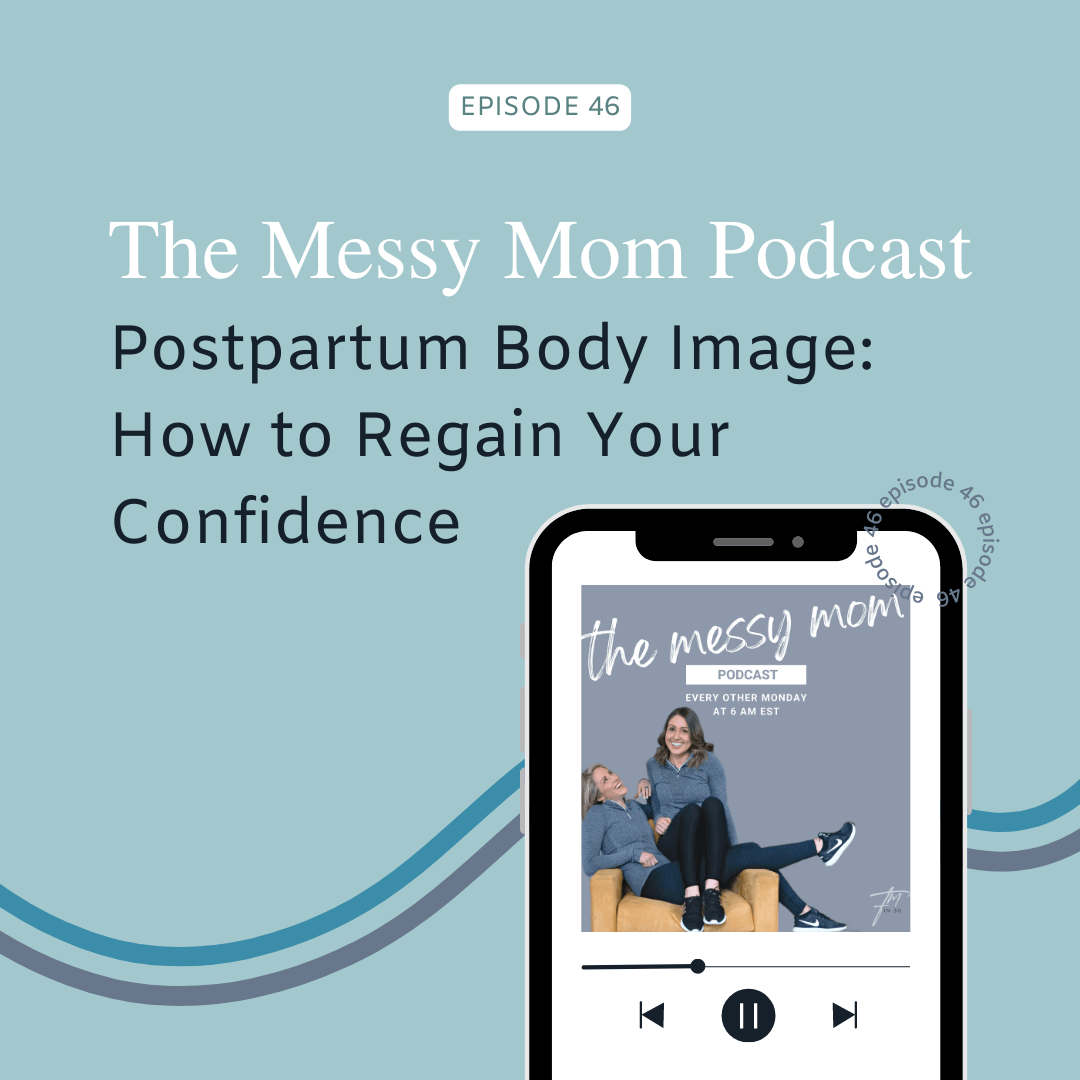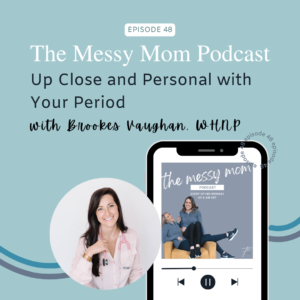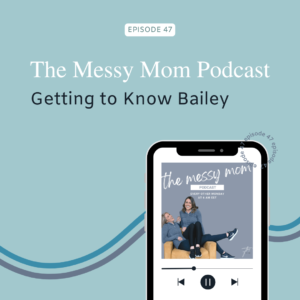CLICK PLAY TO LISTEN TO POSTPARTUM BODY IMAGE: HOW TO REGAIN YOUR CONFIDENCE:
Postpartum Body Image: How to Regain Your Confidence
We are excited to be back with another episode of the Messy Mom Podcast! But before we begin, in case you missed our last episode with Marnie Madras, founder of Rumbly, where we flipped the narrative when it comes to pregnancy, make sure to go back and check it out. It’s a good one!
This week, we’re diving into a topic that many can relate to: postpartum body image. Bailey understands that many can relate to feeling different during the postpartum period. It’s almost as if you’re not fully in your own body due to all the changes happening. From sleep deprivation, healing and fluctuating hormones, it’s easy to feel a bit down on yourself at times.
Join us in this episode, as we dive into the topic of postpartum body image and ways that you can regain your confidence. We discuss expectations postpartum, functional fitness, Diastasis Recti, and much more.
Expectations Postpartum
Cari starts by highlighting the expectations that both you and society have regarding what you should be and how things should appear during the postpartum period. But everyone’s postpartum is so different. Even if you have all the information, you can’t tell someone how they’re going to feel until they go through it themselves. This leads us to our first point, it’s important to normalize your feelings and adjust your expectations.
And remember, you are not alone. Many women experience a lack of confidence in that newly postpartum phase.
Bailey actually found a longitudinal study from 2008, that investigated body image changes and possible predictors of different dimensions of body image in the first year postpartum.
The study involved 79 women who were followed up since early pregnancy. They provided retrospective reports on their pre-pregnancy body image and concurrent reports on their body image during late pregnancy. Questionnaires were completed at 6 weeks, 6 months, and 12 months postpartum, focusing on body image such as perceived fatness, attractiveness, shape, weight, strength, and fitness. The study found that women experienced greater body dissatisfaction in the postpartum period compared to both pre-pregnancy and late pregnancy. The most significant concerns were at six months postpartum.
So, she thinks right there that tells you that even when you are in that late pregnancy stage, a lot of women feel more confident at that point than they do at 6 months postpartum.
Now, it’s important to acknowledge that individual experiences may vary, it is generally observed that most women don’t feel 100% amazing during the 38/39 weeks of pregnancy. Interestingly, many tend to feel more confident at that stage compared to six months postpartum. This is interesting because, by the six-month postpartum mark, the baby has already arrived, and you’re a little bit, if we’re talking size-wise, smaller.
Cari points out that she feels this is where the expectations play a role. Even at six months postpartum, if someone regains their confidence earlier or loses all the weight, the personal and societal expectations can still be in your head. We’re often led to believe that we are supposed to bounce back. Therefore, when the six-month mark hits, in your head it’s like, why do I look like this 6 months postpartum when really it should be, you’re only 6 months postpartum.
Bailey thinks she is exactly right. Society puts so much on women that they should “bound back” and be back at their pre-baby weight, glorifying that. It used to be in magazines but now we have social media to see all these people online that look like they have it all together, that they’re in their pre-baby jeans in a couple of weeks, and that’s just not realistic. So at six months postpartum, if you’re looking at yourself or, stepping on the scale, and you’re like, “Well, why am I not like that? Why is it so hard for me?” Then you can start to get down in the dumps and go back to the pregnant vs not pregnant.
And we both have struggled with it. Even if you are the size you were before, it’s still different. For Cari, her size came back rather quickly with her first pregnancy but she looked different. She remembers thinking about how her muscle mass was gone and how weak she felt.
For Bailey her situation was a little different. She had Crew in the dead of summer, so when she was pregnant she was wearing all the tight dresses, showing the bump and really feeling confident. But once he was born, she was like “Okay, how am I going to dress myself? None of my shorts fit me. I remember I tried to put my jean shorts on, they went right above my kneecap. I was like, okay, that’s not happening.” And she didn’t want to wear the tight cute dresses anymore nor could she wear sweatpants and sweatshirts in that 90 degrees weather. That was the moment for her that she realized her body was different, nothing fits her. But she tried not to let herself sit in that too much because she did just have a baby and her body just had to stretch for nine months. So, she went to Target and got a bunch of clothes in bigger sizes, and she decided it is what it is. It still took her time to start regaining her confidence but it helped to start gradually getting back into routine.
So, normalize that feeling and flip your expectations. That doesn’t mean you can’t appreciate and want to change your body. But having a more realistic timeline of it’s not going to happen in 3 months, it’s not going to happen in 6, it might not happen in 9 and you’re lucky if in 12 months, you’re on a good path in terms of how you feel about your body. You can change a lot in 12 months strength-wise and functional-wise, but just that confidence and feeling good again, you’ve got to give it at least a year.
On the flip side, you have that same pressure for if you do want to spend time and effort on yourself and to get yourself, we are not going to say pre-baby body, but you can want that. But having that is, again, not selfish and there’s nothing wrong with wanting to regain your health and your strength. You really just have to figure out what it looks like for you and what do you want versus taking it all in.
Functional Fitness
We always like to say focus on the functional fitness aspect of it and the aesthetics will come. So, for Cari, yes her aesthetics looked different but for her, it was she felt weak. So, what could she do to change that?
And there are a lot of things you can do. So, instead of focusing on the scale and the size of your clothes, not that there is anything wrong with that, but they’re unrealistic goals to set the first 6-9 months.
Instead of that, if you would focus more on strength and functional goals, like regaining your pelvic floor, strengthening your core, physically engaging with your baby like lifting, lowering, getting off the floor, and holding them. As motherhood is very physical and they’re only getting bigger.
You have to think about how is my body functioning versus the aesthetic of everything. Yes, of course, aesthetics are nice, but that will come later. Especially if you are focusing on how to gradually build back strength, and what we would say is the proper way, which is starting progressive.
So, after you have a baby, your alignment shifts, you have relaxants still in your system which makes your bones, ligaments, joints, and everything a little bit more loosey-goosey. So you really have to make sure that you are focusing on how to do it not only safely, but effectively.
And that’s why we are so passionate about making sure that you’re doing it in a progressive stage rather than just jumping back into it with hardcore hit training workouts or planking on your toes. Because what ends up happening when you jump back into workouts that you were doing prior (or even harder) is it can cause issues later on, like diastasis recti. This can actually make things more challenging, even though you may believe that you’re doing what’s best for yourself.
Start with deep breathing techniques to reconnect with your core, your pelvic floor, and finding that mind-body connection. Then gradually, add in body weight exercises then strength building exercises to build on that versus trying to go too hard too soon. You can avoid potential issues later and that can make aesthetics not apparent.
You have to think of it as they are stages. So, you have to do all the checkpoints like, ‘Do I feel good doing this? Do I feel good doing this?’ Jump to the next stage. It can’t be like, ‘Yeah, I’m good. We’ve done this for about 10 weeks and let’s just jump over here’ because it can come back to bite you if you haven’t followed a progressive model and done step by step. It’s very easy to say ‘well, I feel good. Why can’t I go to this step?’ When there’s a lot of in-between range where you still have to work it progressively.
So, that’s the main concern that you are following and listening to people that are doing it safely and effectively.
Postpartum Period is like Major Surgery
We’ve discussed this previously that giving birth is such an athletic event and then what happens after is an injury to the body. So, we have to look at the postpartum period as a complete healing process, like we would any other major surgery.
For example, if you have a torn ACL, you are babying that knee for a long time before you’re doing anything with it physically. When you are, you’re progressing it. You don’t just go run a marathon after you have ACL surgery. You start doing physical therapy, and then you start slowly adding.
And that’s how we have to look at birth and the postpartum period. That’s when that grace happens with yourself too, knowing that, ‘Okay, I just grew a human. I just had a major delivery, whether it was vaginal or c-section (which, in most cases, c-section is even more intense because that’s true surgery).’ But we have to look at it that way.
It’s okay to not look and feel how you did before, it’s going to take some time.
Diastasis Recti
We mentioned diastasis recti a little bit, but we think it’s important for you to know too, that it’s something that you either think you have or you’ve been told you have.
But 100% of women have diastasis in their third trimester. It’s completely impossible for you not to because your body has to expand to make room for the growing baby. Then on delivery day, it’s not like it just magically zips back together.
Unfortunately, when it comes to diastasis, proper healing requires time and care, which can extend even years into postpartum. While there might be a small percentage of women who didn’t focus on it too much and it does pretty much heal together. Bailey would say that percentage is really small and she personally doesn’t know anyone who that has happened to.
You may be familiar with diastasis, commonly referred to as the “mom pooch.” While we dislike the term, it’s how many women and society label it. We often encounter women who come to us and say “I’m exercising, I’m strength training, I did all the things, and I made it progressive, I didn’t exercise too soon but I just feel like I can’t get rid of this mom pooch, this little section on my belly.”
A lot of women are unaware that, that is actually diastasis that hasn’t been properly handled. It’s amazing what can change when you return to the basics and focus on deep breathing techniques (which is more than just 360 breath). It involves applying a little bit of tension to the core and progressing little by little. However, it’s not something you can figure out on your own. You have to go to someone who is knowledgeable in this field to properly care for it. Then over time, this may even help the aesthetic side that many women want.
And as women, we are really good at being self-critical and focusing on specific areas that we want to improve. So then we think, “I should be doing core sit-ups every day to get rid of this mom pooch when in reality, you can do sit-ups all day long and you’ll never get rid of the mom pooch or the area you’re talking about if you haven’t properly done the progression model and gone back to figure out how am I pairing that movement to breath? How am I figuring out where the pressure is? How can I understand how to work my pelvic floor into that?” If you don’t have this understanding, even if you do countless crunches and maintain a healthy diet, if the ab muscles aren’t working together again, it won’t go away.
That’s the frustrating part, it’s not that people haven’t been doing all the right things like not eating well or exercising, it’s truly a functional thing that just hasn’t been addressed.
Core Recovery
So, with that, we have a fun and exciting thing to wrap up. We put together a core recovery course years ago when we started because we knew this was an issue. We knew that women really needed help and we didn’t like a lot the resources that were offered a the time because there needed to be a progression model.
For the first couple of weeks after pregnancy, once you’ve been cleared, it’s kind of boring. Workouts are basically physical therapy for your core and your pelvic floor. You are retraining and reconnecting those muscles, which can take time. So, to make it more enjoyable, we have an online fitness program called Fit Mama in 30, and we are offering our Core Recovery Program for free for 4 weeks. Starting June 5th, 2023, we will guide you through the program with videos, live Q&A sessions, and ongoing support. We do plan on doing this on a rotating basis.
Note: It’s important to mention that this program isn’t just for women who are newly postpartum. You could be several years postpartum or planning on having a baby in the future, if you’ve never fully addressed your core or even if you don’t feel like you have that mind-body connection with your core, that deep breathing can really help engage your core so much more. There is no time limit for when you can heal it or when you find out about it because some people just don’t know.
We will also show you how to test yourself if you have diastasis. Doing this can even help beyond aesthetics; it can help improve functionality, reduce issues like incontinence when sneezing, jumping, or laughing. Things that we thought were common because society said that after you have a baby, this is what happens. But it’s not necessarily normal and this is how you can go about fixing it.
In case you missed it, here is the link again to our Core Recovery Program or you can find it in the resources section below. It’s an entire month completely free, no strings attached.
We understand how hard postpartum body image can be. Cari’s 8 years postpartum and Bailey almost 2 years and we still have our days. We are not perfect by any means, but it’s about finding balance between understanding, yes, things look different but also embracing what you just did, what you have, and what you are capable of.
It’s natural to look down at your core and feel a mix of emotions. We’re not saying it’s going to ever be perfect, but if you have never thought about having diastasis, repairing it or thinking that this could be a cause for maybe part of your discomfort or lack of confidence, try it out as there’s no reason not to.
As always, we hope this was helpful and relatable. Remember, we all have our days, regardless of how recently or long ago we gave birth. It’s about figuring out how you can embrace it and finding ways to support one another. We are all in this together.
This is only the beginning of our conversation on Postpartum Body Image: How to Regain Your Confidence. Listen to the full episode wherever you listen to your podcasts.
Resources mentioned:
- Marnie’s episode on changing the narrative when it comes to pregnancy
- Bailey’s episode sharing her birth story
- Core Recovery Program
- Find us over on Instagram @fitmamain30
- Try any of our Fit Mama in 30 programs completely free for seven days. And if you decide you want to stick with us after the seven days, you can get $10 off your membership with the code PODCAST at checkout.





